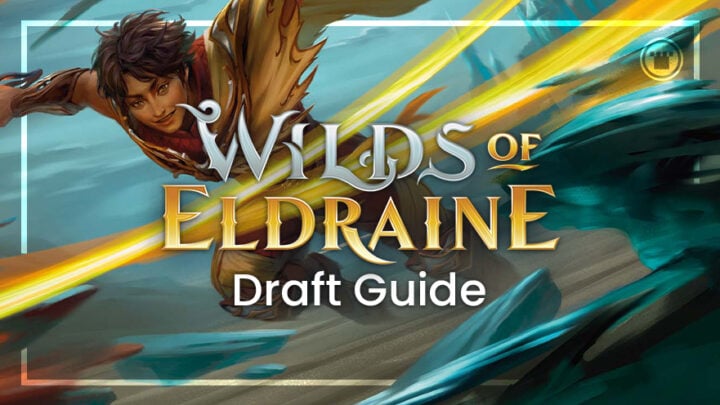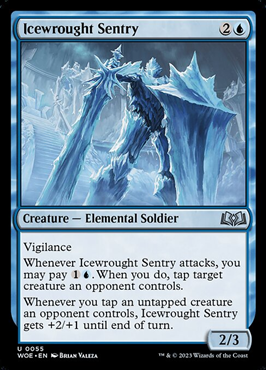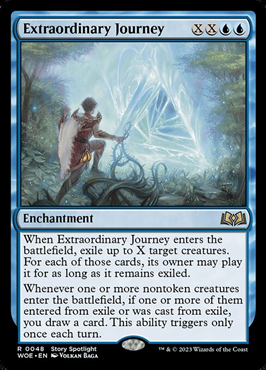Wilds of Eldraine Limited is finally here, and that means it’s time for another Card Kingdom Draft Guide!
The set definitely has a learning curve, but it seems this fairy tale has a happy ending after all. After jamming almost 100 Draft games researching this guide, I’m convinced this new adventure is just as enchanting as the last! So, let’s look at the format in general and all of its color archetypes.
SHAPE OF THE FORMAT
The first thing to do when approaching different Draft formats is figuring the pace of play. How long do the games go? Is it possible to make comebacks? Most importantly, how often is it worth taking the risk to block?
Wilds of Eldraine feels a bit more methodical and balanced than March of the Machines — as you’d expect when the marquee mechanic is adventures rather than battles. At the same time, careful design decisions ensure attacking is still incentivised in most close situations.
It’s not too fast, and not too slow. Wilds of Eldraine Limited feels juuust right!


There are many interesting design themes interwoven throughout this set, but the definitive mechanics are adventure and bargain. As it did in the original Throne of Eldraine, the presence of adventure on creatures tips the scales toward slower, resource-rich play. I do like that this time the actual effect of said adventures offer utility or combat tricks rather than outright removal or win conditions.


Otherwise, Bargain is new in WOE — adding an optional “kicker” effect to many spells if you sacrifice an artifact, enchantment or token as an additional casting cost. Bargain appears on key staples of every color, so it measurably impacts almost every decision you make drafting and playing this set. The big thing to remember is you cannot sacrifice non-token creatures for bargain costs, even if you’d like to.
It’s a hard restriction to really appreciate until you’ve played a few games. I’ve seen even Hall-of-Fame players habitually avoiding removal auras in their first draft runs because they’re usually bad against sacrifice mechanics. But unless you’re using your Pacifism effect on a 1/1 token, that’s not something you need to worry about with bargain.
The emphasis this places on token (and artifact) creatures leads to very unique gameplay considerations, albeit ones you might need to learn the hard way. For example, I managed to throw away my second draft run by blocking wrong against my opponent’s all-in attack. Blocking a Ratcatcher Trainee instead of their Rat token saved me an extra point of life but meant they still had a token around post-combat to exactly kill me with High Fae Negotiator!
Wilds of Eldraine initially seems like it has a thousand types of permanents and tokens chaotically jammed into every game. But after a few drafts, I think most players will be able to see the forest for the trees: it’s all either Adventures or (fodder for) bargain spells.
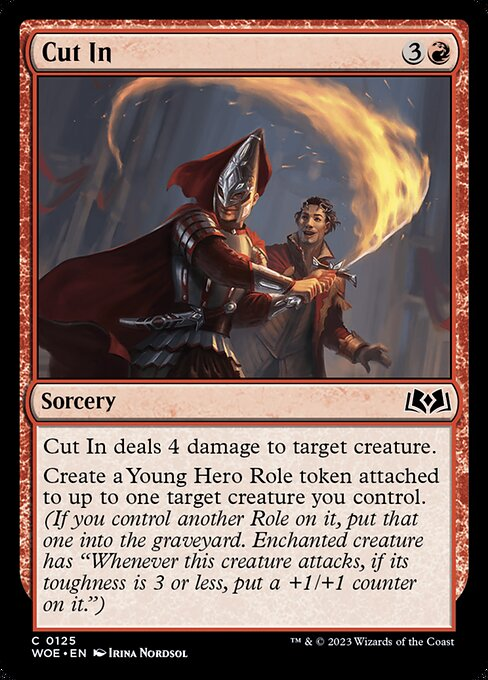
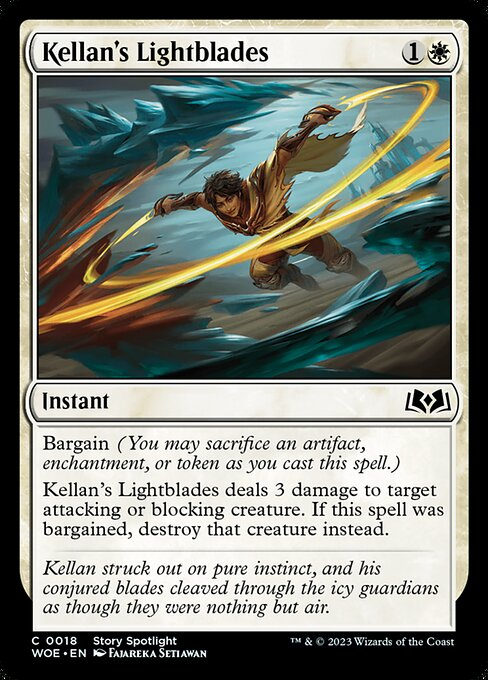
As for the removal, WOE has a clear pecking order when it comes to which colors. Red has four good-to-great options at common, plus Stonesplitter Bolt and Witchstalker Frenzy. White’s arsenal isn’t quite as stacked, but Kellan’s Lightblades is the best common removal in any color, and its other options all double as enablers for white’s key mechanics.
Black, green and especially blue lack the same depth and coverage of common removal. They must rely on having the biggest creatures to control the battlefield. This is part of what gives the set a slower, more back-and-forth feel: if you get enough mana to try and stabilize with a single huge blocker, it’s pretty difficult for your opponent to just blow it away and keep swinging.
In terms of mana, this set has a decent slew of both ramp and fixing cards, with a little overlap in the middle. Mostly these are green based, and the commons are highly sought after since many green drafters are actively trying to play four or five colors.

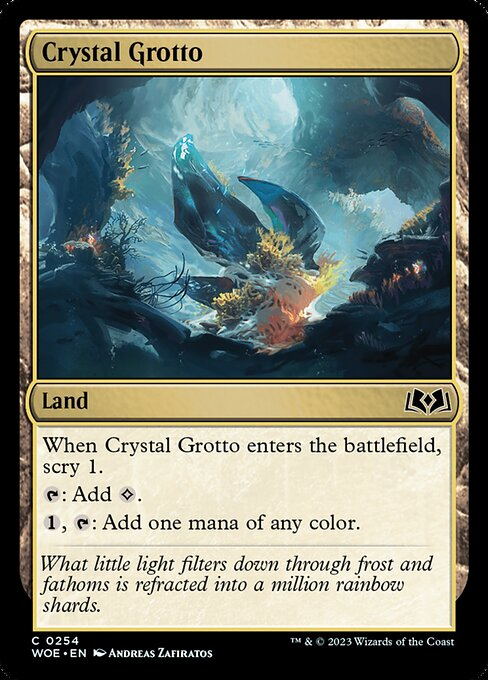
For non-green decks, you can still get three different fixing lands, a couple of cheap color-filtering cards and some (mostly red) Treasure generators. Meanwhile, the colorless options are essentially always worth grabbing where you can afford it, especially the lands and Scarecrow.
Not only do they ensure consistent access to your two main colors, but securing two or three of them early on unlocks the option to take (and use) off-color adventures, creature-lands and gold cards which would otherwise be sketchy choices.
Most non-green decks should probably stick to two colors, perhaps with a splash card or two somewhere if you can get enough fixing lands to do that without eating into your main colors. Green enjoys some extra flexibility, and both green/red/blue and green/white/black are viable decks thanks to strong overlap between their constituent two-color themes.
COLOR PAIR ARCHETYPES
This set does a great job of avoiding the very common cliche themes in each color pair, instead introducing new or underutilized ideas for those archetypes. Some color pairs are relatively all-in and self-contained in their suite of cards while others are much more about mixing the set’s shared mechanics in slightly different combinations.
Tap-Down

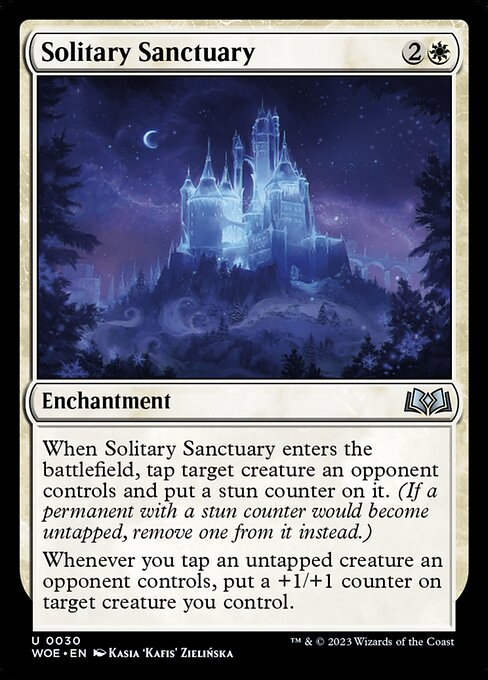
The idea of blue/white generating value triggers from tap effects like Frostbridge Guard has been seen before on random oddball cards like Verity Circle, but never as a fully-realized archetype.
Both blue and white have a deep list of tapping effects to fuel this gameplan: Plunge into Winter, Rimefur Reindeer, Bitter Chill, Vantress Transmuter and Succumb to the Cold best among them. You can also get creative and use something like Stockpiling Celebrant (white’s most flexible common across all archetypes) to reset the relevant ETBs; it’s not a difficult engine to assemble.
If you can find the payoffs (especially Solitary Sanctuary) then you’re very likely to enjoy an open lane to a focused UW deck, whether it’s one designed to blow past people in a hurry or slowly grind out games with card draw. However, it’s still important to prioritize generally strong cards and entertain other potential synergies you can add to the deck, such as spells-matter (with Aquatic Alchemist) or Faeries (Snaremaster Sprite is an easy bridge for those two).
Very few Wilds of Eldraine decks will be able to feast off one single mechanic for every pick. But at least in UW you can enjoy knowing that essentially nobody else is competing for your key cards.
Enchantment Bargaining
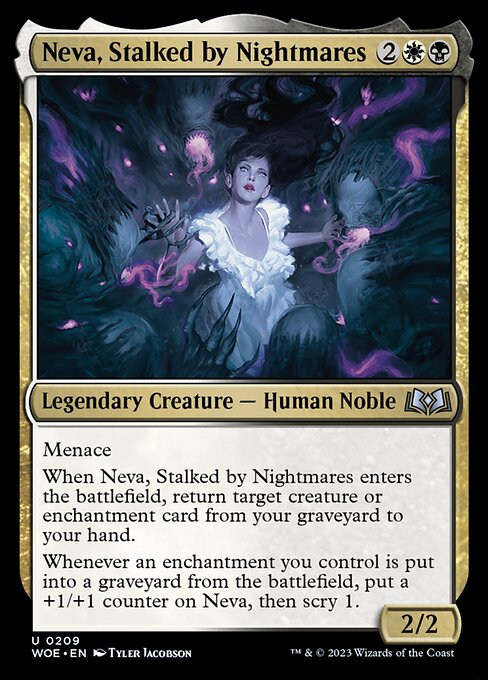

As seems to happen in a lot of sets, the three Abzan color pairs (white/black, green/white, green/black) somewhat blend together into a general “midrange attrition” style — this time fueled by bargain-able permanents and support cards that squeeze even further value from such transactions.
White lacks the Food generation of the other two colors, so in this version of the deck we get to tunnel-vision exclusively on the enchantment package. Support cards like Wicked Visitor, Warehouse Tabby, Knight of Doves, Savior of the Sleeping and Slumbering Keepguard ensure we get that value on both the way in and the way out.
Warehouse Tabby and Knight of Doves are especially good when you’ve got a deck full of bargain spells, as they effectively double your supply of sacrificial permanents. You’d obviously prefer to sacrifice enchantments where you can, though, so look out for role-generators like Cursed Courtier, Conceited Witch, Unassuming Sage and Besotted Knight, as well as the various non-creature effects that create roles as a bonus.
Roles are especially good because “overwriting” a role already on your creature can give you enchantment-death triggers on command. This also applies to Hopeless Nightmare and Hopeful Vigil. Just remember it doesn’t work on role tokens your opponent created, even when they’re on your creatures.
Celebration Aggro


Sequencing is always a crucial element for aggro, and celebration really drives that home. We want to make sure we can turn these triggers on consistently and at different timings. The important common payoff creatures can all benefit from their triggers mid-combat.
Ratcatcher Trainee is a real star for generating two permanents at instant speed (plus an extra one later), but we’ll accept most cards that do one or the other. It’s not hard to play one permanent pre-combat to then set up a nasty blowout with Monstrous Rage or Flick a Coin.
We’re also happy with any effect that tacks a free permanent onto an already-desirable effect. Cut In, Cooped Up and Twisted Fealty are all excellent here.
The removal in red/white is probably the best of any color pair, and you won’t go wrong jamming all you find alongside a bunch of aggressive creatures. If you don’t have enough firepower to win quick, you can extend your curve with red’s beefy five-drops or Stockpiling Celebrant shenanigans — or you can try to spike an Impact Tremors or Raid Bombardment off the bonus sheet and close games out the cheap way.
Enchantment Aggro
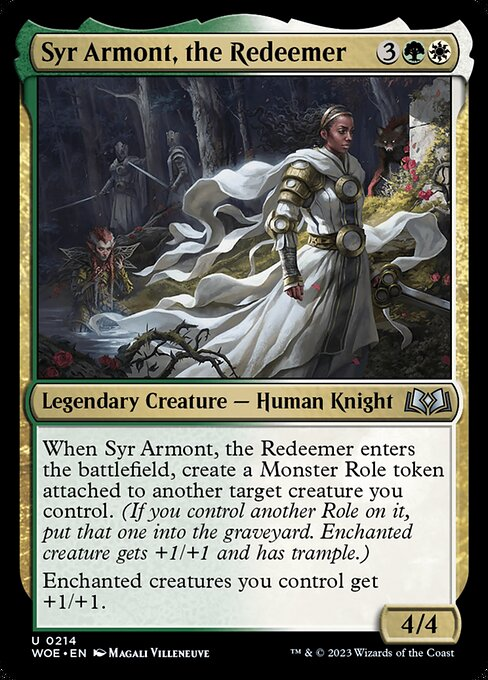

Looking at green/white’s “signpost uncommon” should give you the right impression of this color pair: it’s not doing anything that fancy. The harder-to-pull Tanglespan Lookout aside, there’s not even that many explicit payoffs for having auras below rare. You just want to curve out and attack every turn with creatures bigger than their blockers, holding up mana to blow them out.
It helps that GW has a near-monopoly on good combat tricks in this set: Archon’s Glory, Moment of Valor, Leaping Ambush, and Titanic Growth. Even the sudden +1/+1 from Royal Treatment or the adventure of Ferocious Werefox can often tip a trade in your favor.
The always-excellent Kellan’s Lightblades also reaches a new level here because your opponents will be constantly double-blocking against your beefy threats. Charmed Clothier, Dutiful Griffin and Tuinvale Guide dominate flying combat against all the 1/1 and 2/2 Faeries, closing out games that would be hard to win on the ground.
In other formats I might caution against taking too many non-creature spells, but in WOE I would actually rather have too many than too few. Take advantage of how bad the removal is at killing X/4s and above, and make sure you get on offense as soon as possible to start forcing those ugly blocks.
Faerie Control


I’ve avoided putting the blue/black gold uncommon as the lead image here to make a very important point: this deck is really not about making your Faerie creatures better or even having a lot of them!
The statlines of our creatures are simply pathetic by aggro standards, and we have no real lords or other ways to juice that up. Obyra, Dreaming Duelist isn’t a fix for that; she’s a slightly more efficient body that hopefully gets to ping once or twice before she dies.
Instead, we have to rely on removal, blockers and disruption to keep opponents neutralized while we chisel away at their life. Dream Spoilers or Storyteller Pixie can be haymakers if you’re able to untap with them, but it’s more likely to be the consistent Barrow Naughty and Obyra’s Attendants that carry the workload of winning games.
Naughty is our strongest common by a mile, and the poster child for how much most Faeries can benefit from a +1/+1 role aura. Sorcerer is probably the best if you can get it, but Wicked comes for free on tons of black spells and will do the job just fine. You can also splash white for Solitary Sanctuary and get a similar benefit from the +1/+1 counters, unlocking the adventure on Threadbind Clique at the same time.
Spells (and Adventures) Matter

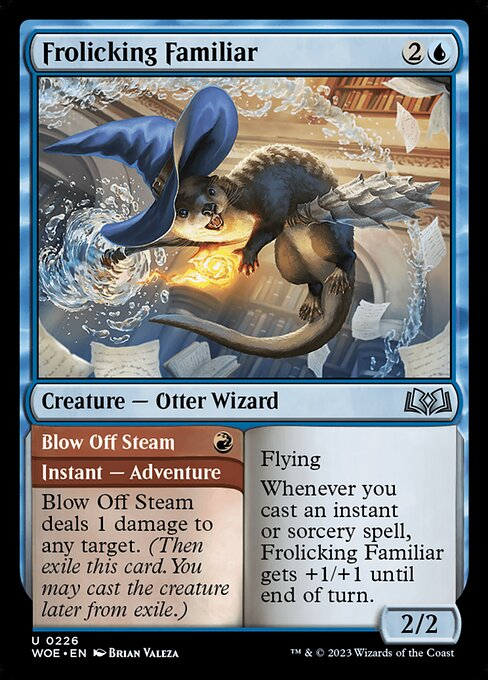
Like with red/white, Wilds of Eldraine offers us a unique variation on a very well-worn red/blue Draft strategy. We have the set’s most efficient options for removal, countermagic, bounce and card draw, plus a handful of decent-to-good payoffs for filling our deck with instants and sorceries. If you’ve drafted virtually any set in the last decade, this will all sound familiar to you.
But the big twist here is our arsenal of adventure creatures. Basically all those payoffs have been explicitly worded to work with adventures just as they would with an actual instant or sorcery card.
This lets us play a creature curve that’s more reminiscent of a green deck, taking over the late game with 4/5s and 6/5s rather than relying on pure tempo to steal wins. One or two copies of Beluna’s Gatekeeper can practically beat some decks by itself. Remember that good answers for big bodies are harder to come by than you’d expect.
Since we have inherent card advantage from adventures plus lots of high-impact late game plays, the top priority for your draft should be making sure you keep up over the first four turns. Red’s removal package is highly contested, but you can also get by with Bitter Chill, Spell Stutter, Johann’s Stopgap, Candy Trail, Skewer Slinger, Reckless Catapult… anything that helps bridge the gap until your cards become better than theirs.
Ramp


The shape of the blue/green game plan is very similar to blue/red, and of course these three colors can be mixed and matched in a similar way to the Abzan colors we mentioned earlier. If you stick to straight UG, though, you’re trading the premium early removal of red for mana generation and food-based lifegain.
It’s perhaps not a better plan, but one I’ve found easier to draft consistently. Up the Beanstalk and Garruk’s Uprising help ensure you’ll always have cards to play with the extra mana from Beanstalk Wurm, Return from the Wilds, Rootrider Faun and Night of the Sweets’ Revenge.
As is often true of UG in Limited, the nicest thing about this deck is its flexibility. Since your game plan is just “generate cards and mana,” you can adapt mid-draft to incorporate whatever synergies or splash colors present themselves.
If you get a few Redtooth Vanguard and Tanglespan Lookout, you can start preferencing role-generation cards. More than one copy of Up the Beanstalk and you’re going to really lean into taking the bigger adventure creatures wherever you can. Find a lot of food support, and maybe you want to splash in some black for Greta, Sweettooth Scourge.
The “start every draft in UG and go from there” maxim is alive and well in Wilds of Eldraine.
Rats
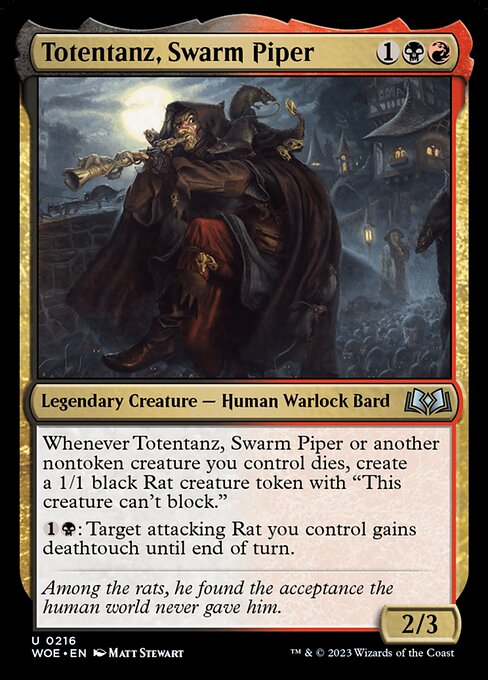
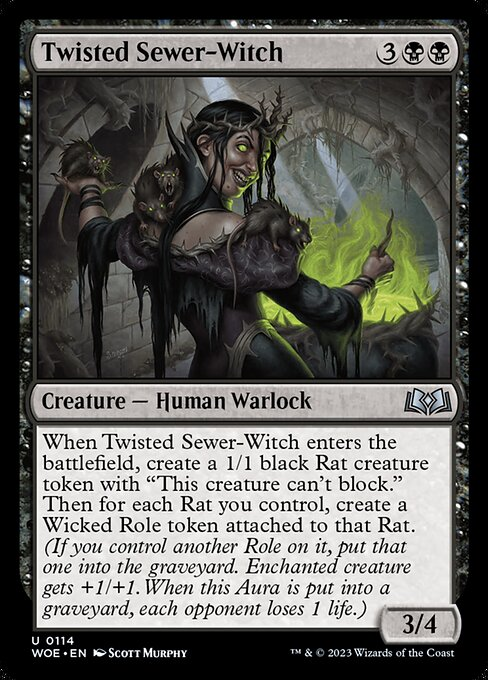
I think this is probably the deck most players are excited to draft first in WOE, and I can’t blame any of you. It’s a huge upgrade over the typical “Red/black Sacrifice” deck in terms of personality.
It also turns out to play better than those usual RB decks — though it is one of the more skill-testing decks in this already-tricky format. Most of those intricacies come from the humble Rat token itself, and the fateful rules text “This creature can’t block.”
Not being able to use your rats as chump-blockers and only rarely as sac fodder (since your outlets are expensive, single-use bargain spells) makes them feel much closer to the “decayed” Zombies of Midnight Hunt than a usual creature token. Unless you’re racing or keeping their board clear of blockers, you’ll usually end up just keeping your rats off to one side, hoarding up a horde until you can cash them all in for maximum value.
It’s an incredible bit of top-down design from the WOE team. When you play this deck right you ARE the Pied Piper, commanding countless tiny bodies in ominous unison.
In terms of the cards that can unlock the aggressive potential of our rats, there are quite a few options. Raid Bombardment off the bonus sheet is devastating, as is Impact Tremors or (if you can snag it) Shared Animosity.
As far as actual WOE cards, Twisted Sewer-Witch, Imodane’s Recruiter and Gnawing Crescendo are the best at immediately ending the game. Then there’s a handful of cards that don’t so much increase damage as help you swing through blockers: Tattered Ratter, Bespoke Battlegarb and Totentanz himself.
The important thing is to not throw rats away for a couple points of damage. There has to be a bigger plan.
Food Midrange


The most flexible and (for my money) strongest two-color version of the G/B/W bargaining decks, green/black still has access to most of the good synergies around enchantments while gaining a very strong suite of food-focused effects.
There’s repeatable Food generation at common, multiple food-typed cards including Food creatures, strong sacrifice outlets to supplement bargain and even cards to reward you for keeping a big pile of Food alive. It’s enough that the word “food” is going to start looking weird to you (if it isn’t already after this paragraph).
As with blue/green, you’ll want to avoid overcommitting to any one theme too early, food included. Better to draft generalized cards like the bargain spells and permanent generators first. Then, once you start to see a pattern in which permanents you’re generating, you can decide to specialize toward enchantments or food.
There are a ton of different little combos hiding inside those broad themes. I’ve personally enjoyed combining Garruk’s Uprising with three-plus copies of Scream Puff, which always seem to be available late.
No two GB decks feel quite alike even before splashing, and that’s the sweetest thing about them.
Ferocious Adventure Aggro


Powerful, straightforward and consistent, red/green might be the best two-color deck in Wilds of Eldraine. The gameplay is pretty close to what I described in the green/white section: your creatures are bigger and more efficient than theirs, and you use that to force unfavorable combat trades which quickly snowball into an unbeatable board lead.
The difference here is in how quickly the damage can scale up. The “power four or greater” triggers (a.k.a. “ferocious” in other sets) give RG the explosiveness of the RW celebration deck but with better baseline attackers.
Compared to GW, RG can replace some of the combat tricks with red’s efficient removal. This tends to convert into more damage since you can spend the card to kill a blocker and attack face instead of killing it after the block has happened.
Then there’s the gulf in power and playability between each pair’s uncommon gold cards and cross-color adventure creatures. Picnic Ruiner in particular is a stone-cold game winner, particularly if you manage to get more than one. The fact that you get highly synergistic adventures on curve-toppers like Bellowing Bruiser and Two-Headed Hunter is icing on the cake.
There’s not a lot more I can say here. Pick a curve of large creatures, add removal and go get your free wins!
ELDRAINE DRIVES A HARD BARGAIN
Personally, I find Wilds of Eldraine is a worthy successor to March of the Machine — both in terms of enjoyment and difficulty. But I’ll take a steady-paced, tricky set any day over something lightning-quick where you don’t even get to make meaningful choices once you’re on the back foot.
Between so many cards having secondary modes, tons of non-creature game objects and the need to juggle overlapping synergies within the same deck, I’ve found myself using up a lot more match time on every decision — and making my share of excruciating blunders. Yet it’s only a matter of mindset to see those disappointments as a learning experience instead, and the satisfaction of mastering a new set of Magic skills is always worth the extra effort.

Tom’s fate was sealed in 7th grade when his friend lent him a pile of commons to play Magic. He quickly picked up Boros and Orzhov decks in Ravnica block and has remained a staunch white magician ever since. A fan of all Constructed formats, he enjoys studying the history of the tournament meta. He specializes in midrange decks, especially Death & Taxes and Martyr Proc. One day, he swears he will win an MCQ with Evershrike. Ask him how at @AWanderingBard, or watch him stream Magic at twitch.tv/TheWanderingBard.

